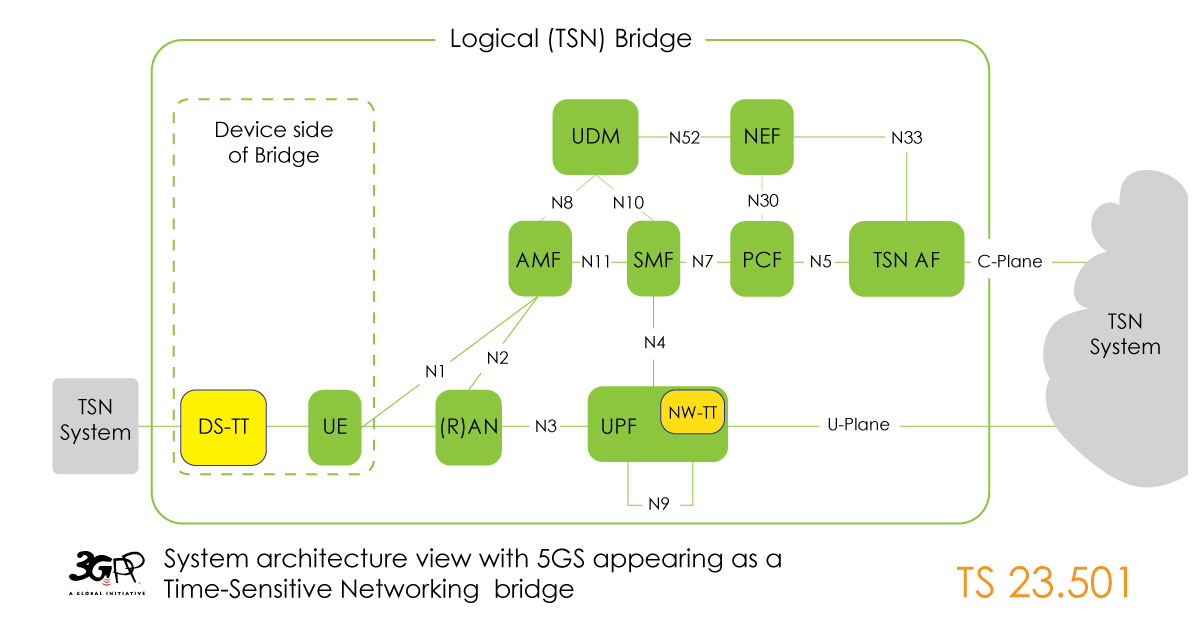May 13, 2020: In order to be able to deploy 5G for new and diverse use cases, including industry 4.0 and factory automation, the 5G system must work in harmony with the communications technologies used in such industries. For this purpose, 3GPP has now made significant progress towards the integration of the 5G system with IEEE 802.1 working group specifications covering Time Sensitive Networking (TSN).
The ‘Vertical_LAN’ work item, in 3GPP Release-16, introduces the following three new and distinct 5G enablers for Industry 4.0;
- Support for Time Sensitive Communications by seamlessly integrating the 5G system as a bridge to IEEE TSN. 2. Support for Non-Public Networks. 3. Support for a 5G-LAN type service.
5G Time Sensitive Communications
The IEEE TSN set of specifications is considered the convergence technology that will enable deterministic and low-latency communication in the factories of the future. 5G Time Sensitive Communication is a service that supports deterministic and/or isochronous communication with high reliability and availability. It provides packet transport with Quality of Service (QoS) characteristics such as bounded latency and reliability, where end systems and relay/transmit nodes can be strictly synchronized.
3GPP supports TSN time synchronization, by considering the entire end-to-end 5G system as an IEEE 802.1AS "time-aware system". Only the TSN Translators (TTs) at the edges of the 5G system need to support the IEEE 802.1AS operations. UE, gNB, UPF, NW-TT and DS-TTs are synchronized with the 5G GM (i.e. the 5G internal system clock) which keeps these network elements synchronized.
The TSN Translators fulfil all functions related to IEEE 802.1AS. Furthermore, time sensitive communications (TSC) assistance information has been introduced to provide the deterministic traffic pattern to the 5G RAN and to facilitate optimized scheduling of time sensitive traffic.
5G Non-Public Network
A Non-Public Network (NPN) enables deployment of 5G System for private use. An NPN may be deployed as:
- a Stand-alone Non-Public Network (SNPN): operated by an NPN operator and not relying on network functions provided by a PLMN, or
- a Public network integrated NPN (PNI-NPN): a non-public network deployed with the support of a PLMN.
An SNPN is identified by a combination of PLMN ID and NID (Network identifier). An SNPN-enabled UE is configured with subscriber identifier (SUPI) and credentials for each subscribed SNPN identified by the combination of PLMN ID and NID. The following are the possible assignment models for NID:
- Self-assignment: NIDs are chosen individually by SNPNs at deployment time (and may therefore not be unique) but use a different numbering space than the coordinated assignment NIDs.
- Coordinated assignment: With this model, NIDs are assigned using one of the following two options:
- The NID is assigned such that it is globally unique independent of the PLMN ID used; 2. The NID is assigned such that the combination of the NID and the PLMN ID is globally unique.
SNPN RAN broadcasts PLMN ID and NID in the System Broadcast enabling network (re-)selection, overload control, access control and barring are supported using PLMN ID and NID.
In addition, 3GPP Release-16 also specifies the ability for UE to obtain PLMN services while camping on the Stand-alone Non-Public RAN - when the UE has a subscription and credentials to obtain services from both PLMN and SNPN.
In the case of ‘Public Network Integrated-Non-Public Network’ (PNI-NPN) , PLMN ID identifies the network, CAG ID identifies the Closed Access Group (CAG) cells. A CAG cell broadcasts one or multiple CAG Identifiers per PLMN.
Network selection and reselection is based on PLMN ID. Cell selection and reselection, access control based on CAG ID. The CAG cell shall broadcast information such that only UEs supporting CAG are accessing the cell.
5G LAN-type Service
5G LAN-type service provides services with similar functionalities to Local Area Networks (LANs) and VPN’s but improved with 5G capabilities (e.g., high performance, long distance access, mobility and security). The 5G LAN type service enables management of 5G Virtual Network (VN) Group identification, membership and group data. The 5G VN Group management can be configured by a network administrator or can be managed dynamically by third party apps (AF).
In order to support dynamic management of 5G VN Group identification and membership, the NEF exposes a set of services to manage (e.g. add/delete/modify) the 5G VN group and 5G VN member.
The NEF (Network Exposure Function) also exposes services to dynamically manage 5G VN group data. Furthermore, 5GS supports optimized routing by enabling support for local switching at the UPF without having to traverse the data network for UE-UE communication when the two UE(s) are served by the same User Plane Function.
Enhanced support for Industrial IoT in Release-17
As described above, 3GPP Release-16 specifications support key enablers for Industrial IoT in 5G system. 3GPP has also informed IEEE about the maturity of IEEE TSN integration in the 3GPP specification via a recent liaison statement (S2-2003508).
Release-17 work aims to define further enhancement for integration with IEEE TSN including support for uplink synchronization via 5GS, support for multiple working clock domains connected to the UE, and support for Time Synchronization of UE(s) with the TSN GM attached to the UE side via 5G System.
Release-17 will also introduce enhanced support of deterministic applications (beyond IEEE TSN) by exposing network capabilities to support Time Sensitive communication services and optimizations for UE-UE Time Sensitive Communication. Furthermore, Release-17 also aims to support further enhancements for SNPN along with subscription/credentials owned by an entity separate from the SNPN, UE onboarding and provisioning for SNPN, and support for voice/IMS emergency services for SNPN.
Email Newsletters
Sign up to receive TelecomTV's top news and videos, plus exclusive subscriber-only content direct to your inbox.




